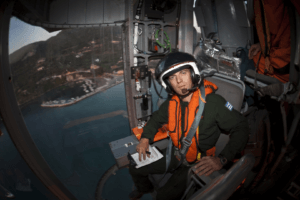
The IAWF annually awards a range of scholarships to students, scholars, and researchers working in the wide range of interdisciplinary fields that increase our knowledge and management of wildfires and bushfires. Dr Miltiadis Athanasiou was awarded the IAWF Doctoral Student Scholarship in 2014. Read more about what he has been up to since as a scientist, a teacher and a fire fighter.
+
by Dr. Miltiadis Athanasiou
My research work includes data collection on “live” wildfires and relevant analysis. I have produced several publications documenting wildfires and analyzing fire behavior (fire spread, spotting, crowning) in Greece and I am the recipient of the International Association of Wildland Fire (IAWF) Doctoral Student Scholarship for 2014.
Studies in wildfire
I studied Environmental Science at the University of the Aegean, Lesvos, Greece and I have also received a M.Sc. Degree in Prevention and Management of Natural Disasters from the National and Kapodistrian University of Athens. My post-graduate dissertation was on the topic of wildfire management and I pursued my PhD degree in the same field at the same University. The title of my Ph.D. dissertation is “Development of an optimal methodology for forecasting forest fire behavior in Greece” [1].
Receiving the IAWF scholarship, was a strong encouragement for me in my final push for completing my PhD thesis and it made me feel deeply honored. Although the scholarship helped me offset some costs, the financial aspect comes second when considering that the scholarship came from the IAWF, which is a true global effort for advancing all aspects of wildfire science and real-world applications.
Measuring wildfire behaviour is a difficult subject with highly demanding data collection procedures and tasks which I have carried out effectively and with safety, helped by my 18 years’ experience in firefighting.
Work as a trainer and a teacher
My firefighting training and operational experience commenced in 2000 with the Special Units of Disaster Response, Hellenic Fire Corps. I became Lead Supervisor and Operational Coordinator, of a Natural Disaster Response and Relief Volunteer Team and I have also served with the 6th Fire Department Station of Athens as a volunteer firefighter (fire engine crew member). I have also worked in aerial firefighting, as crew member of heavy-lift (Type I) helicopters in Greece, for five fire seasons (2011-2015).
I have 20 years experience in environmental management and have built significant experience in forest fire management. I have undertaken and carried out research projects, studies and operational plans for wildfire management and suppression, cooperating with the National and Kapodistrian University of Athens, the Technological Educational Institute of the Ionian Islands, private companies and with the Non-Governmental Organization WWF Hellas.
I also teach the “Topography and Geoinformatics in Disaster Relief and Rescue Operations” Course, in the Hellenic Fire Academy and the “Wildfires management” courses in two postgraduate programs at the National and Kapodistrian University of Athens.
Last but not least, I give lectures at fire stations across Greece, teaching both professional and volunteer firefighters, about the topics of wildfire behaviour, hazards, human factors, safety and health on the fire line, and forest firefighting tactics.
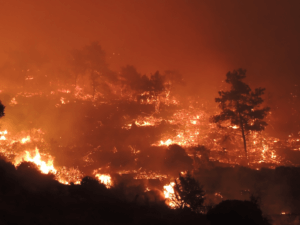
Research on fire behaviour prediction in Greece
My research aims to improve wildfire behaviour prediction in Greece and the Mediterranean region, to support fire management (prevention and suppression) and to improve fire fighter safety.
To begin with, my research strove, at first, to provide scientifically supported answers about the accuracy and reliability of predictions of existing surface fire behavior modeling systems ([2], [3], [4]) when used with Greek fuel models as inputs. Furthermore, a similar evaluation of an existing crown fire behavior prediction system [5], has been conducted, also. My research has addressed questions such as comparing fire modelling (with its expected accuracy) to the empirical capacity of officers of various levels of firefighting involvement and experience to forecast fire behaviour for a set of conditions; it examines the role and thresholds of non-linear phenomena such as spotting [6] and crowning as well as of extreme phenomena, such as the onset of strong plumes and megafires [7].
The greatest challenge for tackling these questions is obtaining appropriate wildfire behaviour data. Starting from my M.Sc. work in 2007 and continuing every fire season, I have been developing a database of fire behaviour data from field observations and measurements made during wildfires in Greece. It now consists of more than 200 records and is continuously being enriched and extended.
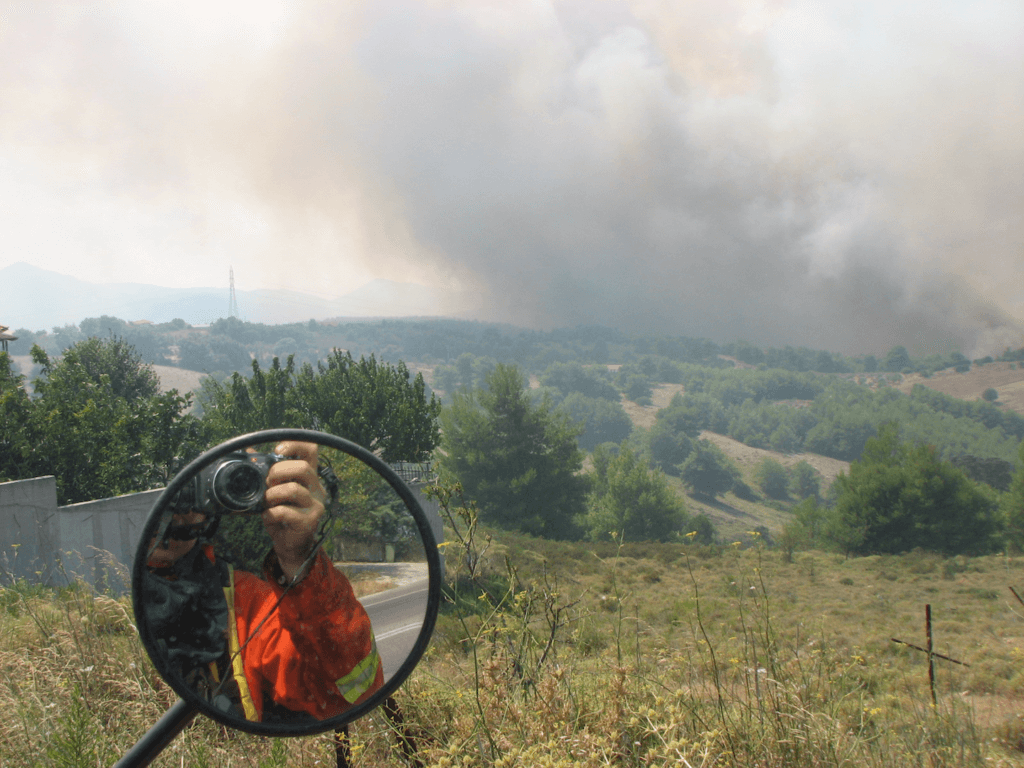
I carry out fire behaviour observations in the field by following running fires, documenting the main controlling factors (fuels, topography, weather, firefighting) and observing and documenting fire behaviour through photographs, video and voice recording. A large number of kilometres has to be travelled, which I mainly do on motorcycle, in order to get to the fires and eventually achieve a thorough and detailed documentation of their evolution, spread and behaviour. Furthermore, office analysis of the recorded material demands endless hours and post fire interviews, live TV footage and internet sources, are also used to double check my personal observations.
The results of my research have been incorporated into a spreadsheet that can be used as a simple and easy to use Decision Support System (DSS). Based on this research, a table has been assembled suggesting the wildfire behavior prediction method of choice for each fuel and fire type while limitations, weaknesses and strengths are also reported, and cases for which there is no available wildfire behavior prediction method are identified.
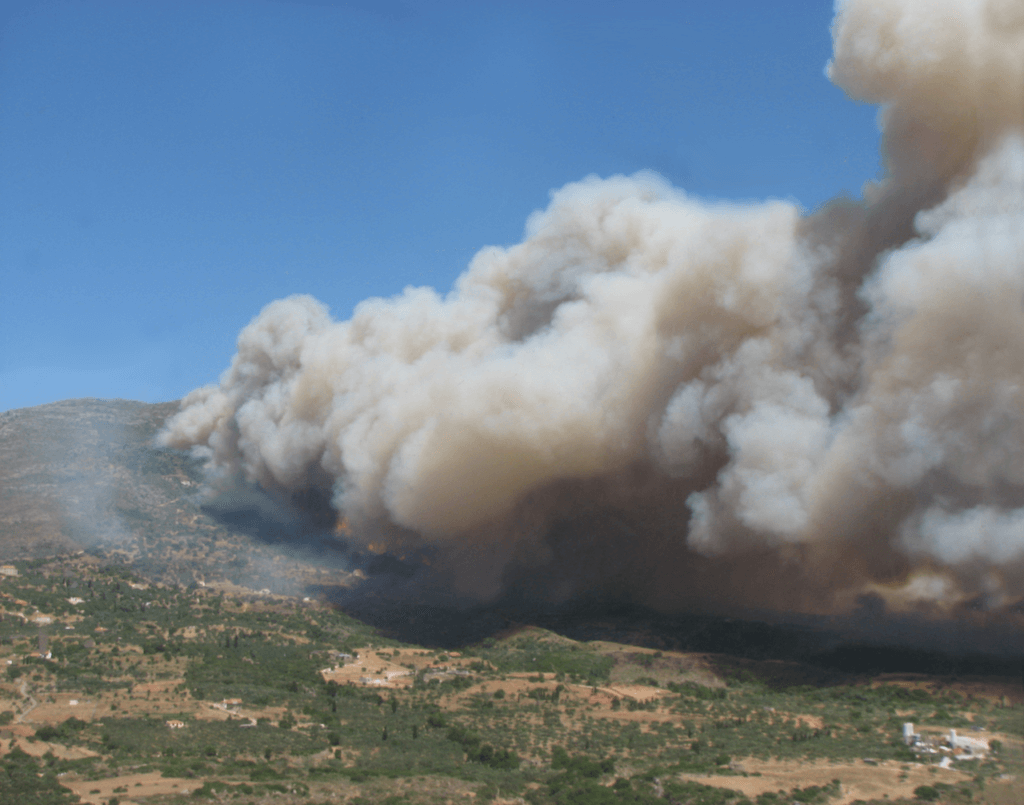
The findings fall into three main categories:
1. Those which are already being used by a few firefighters and peers as a supportive tool in operational firefighting;
2. Those which have been found to be robust enough so that they can be adopted and utilized as a potential basis of decisions or as predictive tools in wildfire management in the country and,
3. Those that must be examined and validated before they could be applied for practical purposes.
Regarding the first category, presence or lack of spotting have been examined for more than 100 fires, categorizing them in four empirical spotting classes (absence of the phenomenon, rare, limited and massive spotting) and correlating these classes with air relative humidity values and with the three forest fuel types on which the firebrands were landed (maquis, small xeric shrubs (phrygana) and grass) [6].
Analysis of the observations and measurements of spotting led to some preliminary conclusions on RH% thresholds for spotting that were presented at the 16th, Panhellenic Forestry Conference, in Thessaloniki, Greece, in 2013 [6]. The data series and the results of this paper were the first approach of this type to the spotting phenomenon in Greece. Though preliminary, those findings are already being utilised by many professional and volunteer firefighters in Greece.
Of course, the analysis of spotting phenomenon has not stopped; the initial data (enriched by those that were obtained during the last four fire seasons) are currently being processed and will soon be submitted for publication.
For the second category, the Greek fuel models that describe tall maquis, short maquis, some phryganic areas and grasslands, respectively, BehavePlus can be a useful tool for predictions of surface wildfire Rate of Spread (ROS) [8] and provide a quick and easy way to do either initial, managerial or real-time fire behavior assessments due to its ‘point-based’ fire modeling approach. Four corresponding statistically significant linear regression equations that have been developed and can be used for adjusting BehavePlus predictions to match “real world” fire behaviour, can also be incorporated in fire spread simulation systems used in Greece such as FLogA [1]. This spatial wildfire spread simulation system was found to produce reasonable fire behaviour simulations, regarding the ROS and the burned area, when these Greek fuel models and realistic wind field data were used as input data [1].
The analysis of the flame length (FL) for the same fuel types that were described by the same fuel models, showed that BehavePlus predictions are not reliable. Moreover, the finding that FL is seriously under-predicted when using BehavePlus with the Phrygana II fuel model [9] to predict fire behaviour in Sarcopoterium spinosum dominated phrygana fields is an important result that can be very useful for the safety of firefighters. It should be seriously taken into consideration in operational firefighting as the underestimation takes place in a narrow band of FL values that includes the FL threshold value of 1.2 m, which is considered as the limit for direct attack on the flames with hand tools [8]. The first results of this effort were presented at the 7th International Conference on Forest Fire Research in Coimbra, Portugal, November 2014 [8].
Even though CFIS was deemed as inappropriate for operational use in Greece before further testing, since it failed systematically to predict the crown fire type and the active crown fire ROS in Aleppo pine forests with tall maquis understory, it might still be quite useful as a training tool for the estimation of crown initiation and could be suitably incorporated in firefighters training courses [1]. The necessary input data can be estimated using the above mentioned DSS, which includes three different ways of Canopy Bulk Density (CBD) estimation for Pinus halepensis forests.
In the third category, empirical equations have been developed for the prediction of surface and active crown wildfire ROS and for the estimation of the minimum surface ROS value for active crowning. Their reliability and the ranges of conditions into which they are valid, need to be tested [1].
For instance, the analysis of the database subsets of passive crown and active crown fires, has led to the generation of a ROS criterion for active crowning in Aleppo pine forests with tall maquis understory. Following the empirical approach of Van Wagner [10], the equation that was developed calculates, for any specified value of CBD, the critical surface ROS value (threshold) above which active crowning can be sustained. Another preliminary result about active crown ROS in Aleppo pine forests is that it is about two times greater than surface ROS in tall maquis understory.
Recently, we developed a fuel model for areas covered by Cistus spp. by using the destructive sampling method. This fuel model is intended to be used as input for fire behavior prediction systems such as BehavePlus. The next necessary step for adopting it, is to test its performance by comparing fire behavior prediction through modeling with fire behavior observations. The overall effort was presented at the 18th Panhellenic Forestry Conference, in Edessa, Greece, October 2017 [11].
Applied outcomes from field-based research
All this work is expected to benefit the Greek fire management community as it will provide scientifically supported arguments on which methods should be employed for fire behaviour prediction, when they should be used and how they should be adopted. International fire managers can also benefit. Increased understanding on the expected accuracy of fire behaviour predictions for Mediterranean fuels can have a significant effect on safety margins establishment during decision making and hence, increase fire management effectiveness in prevention, pre-suppression planning and fire suppression.
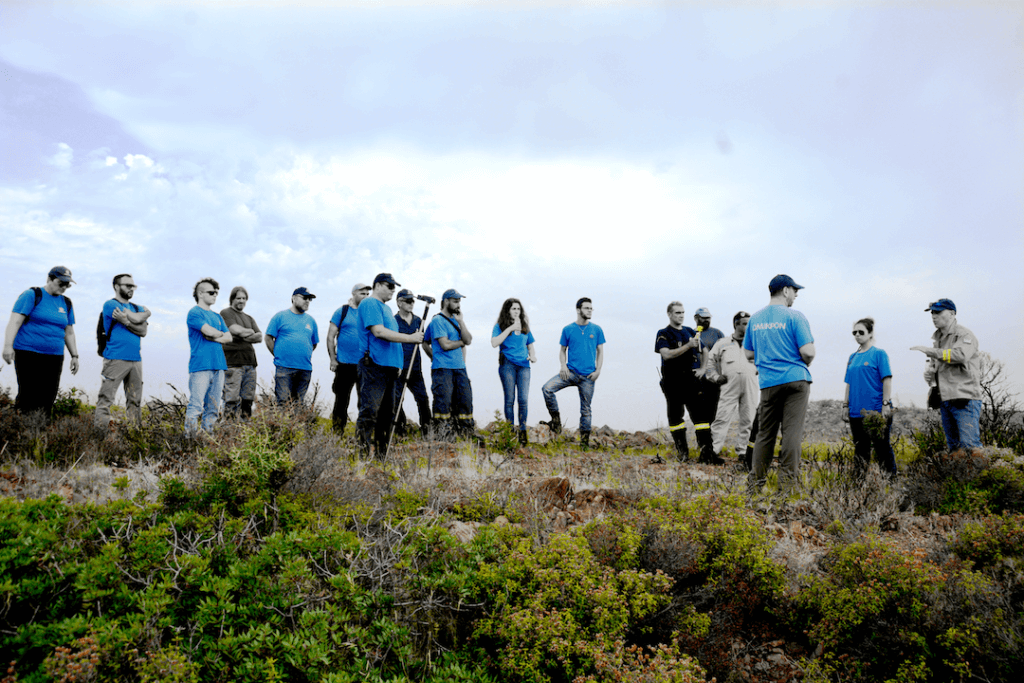
References
[1] Athanasiou, M. 2015. Development of an optimal methodology for forecasting forest fire behaviour in Greece. PhD dissertation, Department of Geology and Geoenvironment, National and Kapodistrian University of Athens, 408 p. (In Greek with English abstract)
[2] Andrews P.L., Bevins C.D. and R.C. Seli. 2005. BehavePlus fire modeling system, Version 4.0: User’s Guide. General Technical Report RMRS-GTR-106WWW revised. Ogden, UT: USDA, Forest Service, Intermountain Forest and Range Experiment Station. 132 p.
[3] Finney, M.A. 1998. FARSITE: Fire Area Simulator-model development and evaluation. Res. Pap. RMRS-RP-4, Ogden, UT: USDA, Forest Service, Rocky Mountain Research Station. 47 p.
[4] Bogdos N. and E.S. Manolakos. 2013. A tool for simulation and geo-animation of wildfires with fuel editing and hotspot monitoring capabilities, Environmental Modelling & Software 46 (2013): 182-195. http://dx.doi.org/10.1016/j.envsoft.2013.03.009.
[5] Alexander M.E., Cruz M.G. and A.M.G Lopes. 2006. CFIS: a software tool for simulating crown fire initiation and spread [Abstr.]. For. Ecol. Manage. 234: S133.
[6] Athanasiou M. and G. Xanthopoulos 2013. Observations of the spotting phenomenon, in wildfires in Greece. 30-40 p. In proceedings of the 16th National Forestry Conference, October 6-9, 2013, Thessaloniki, Greece. Hellenic Forestry Society. 1144 p. (In Greek with English abstract)
[7] Athanasiou, M., and G. Xanthopoulos. 2010. Fire behaviour of the large fires of 2007 in Greece. In proceedings of the 6th International Conference on Forest Fire Research, November 15-18, 2010, Coimbra, Portugal. D.G. Viegas, Editor. ADAI/CEIF, University of Coimbra, Portugal. Abstract p. 336, full text on CD.
[8] Athanasiou M. and G. Xanthopoulos. 2014. Wildfires in Mediterranean shrubs and grasslands, in Greece: In situ fire behaviour observations versus predictions. In proceedings of the 7th International Conference on Forest Fire Research: Advances in Forest Fire Research, 17-20 November 2014, Coimbra, Portugal. D. G. Viegas, Editor. ADAI/CEIF, University of Coimbra, Portugal. Abstract p. 488, full text on CD.
[9] Dimitrakopoulos, A. P. 2002. Mediteranean fuel models and potential fire behaviour in Greece, International Journal of Wildland Fire 11(2) 127 – 130.
[10] Van Wagner, C. E. 1977a. Conditions for the start and spread of crown fire. Canadian Journal of Forest Research. 7: 23–34.
[11] Athanasiou M., Xanthopoulos G., Martinis A., Foukis Th. and St. Gaitani. 2017. Development of a fuel model for Cistus spp. in Greece. 702-709 p. In proceedings of the 18th Hellenic Forestry Conference, October 8-11, 2017, Edessa, Pella, Greece. Hellenic Forestry Society. 1742 p. (in Greek with English abstract)
